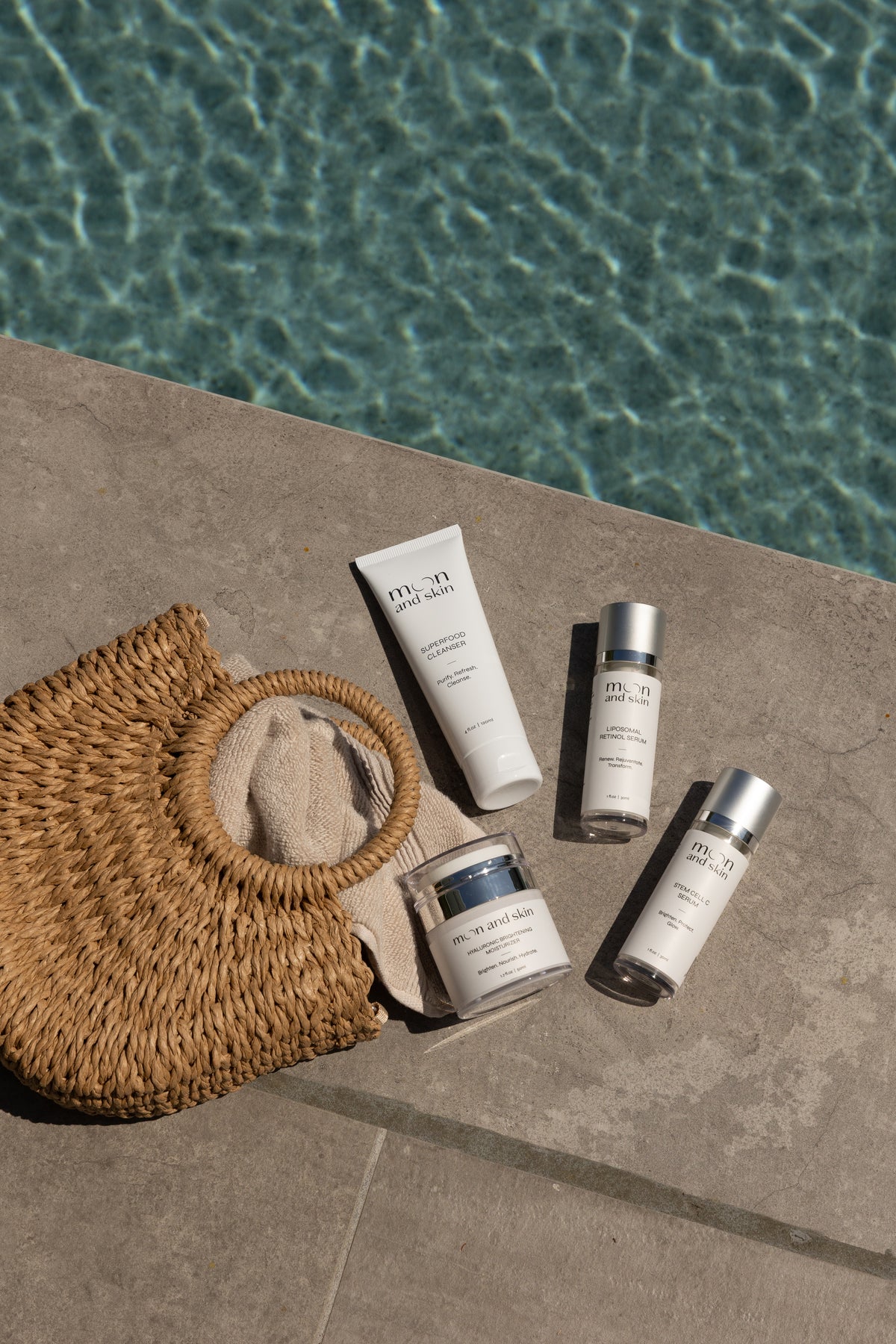Table of Contents
Introduction
Have you ever found yourself staring at the beauty aisle, overwhelmed by the sheer number of products and their price tags? You’re not alone. Recent surveys indicate that the average individual spends over $300 a month on skincare and beauty products, equating to approximately $3,500 a year. This figure can feel daunting, especially when you consider the wide variations in skincare budgets.
At Moon and Skin, we understand that navigating the world of skincare spending can be confusing and even frustrating. With so many options available, determining how much to invest in your skincare routine can feel like an insurmountable task. However, understanding your skin's needs, your personal budget, and how to optimize your spending can empower you to make informed choices.
In this blog post, we will explore how much you should spend on skincare, the factors that influence skincare budgets, and how we can help you achieve beautiful skin without breaking the bank. Together, we will break down the essential components of an effective skincare routine, identify the products that truly deliver results, and discuss the balance between quality and affordability.
Understanding Your Skin Type and Needs
Before we dive into budgeting specifics, it’s crucial to understand what your skin truly requires. Different skin types—oily, dry, combination, and sensitive—have unique needs that can influence your spending. Here’s a brief overview:
- Oily Skin: Often prone to acne, oily skin benefits from lightweight, oil-free products. Look for ingredients like salicylic acid and tea tree oil. Our Superfood Cleanser is perfect for gently cleansing without stripping your skin.
- Dry Skin: This skin type requires rich hydration. Ingredients like hyaluronic acid and ceramides are essential. Our Hyaluronic Brightening Moisturizer can help you achieve that dewy glow.
- Combination Skin: This type may have both oily and dry areas, necessitating a balanced approach. Look for versatile products that hydrate without causing excess oil.
- Sensitive Skin: Ingredients should be gentle and soothing. Avoid harsh chemicals and opt for calming botanicals.
Understanding your skin type will help you determine the kinds of products to invest in and can ultimately inform your budget.
Key Takeaway
Getting to know your skin is the first step in creating a tailored skincare routine that meets your needs without overspending.
Setting a Realistic Skincare Budget
So, how much should you actually spend on skincare? This largely depends on your financial situation, personal preferences, and skincare goals. Here are some guidelines to help you set a realistic budget:
- Percentage of Income: Many financial experts suggest setting aside 5-10% of your take-home income for personal care, which includes skincare. If you're spending more than this, it might be worth reassessing your routine or focusing on fewer, high-quality products.
- Monthly vs. Quarterly: Consider whether you want to budget monthly or quarterly. Some people prefer to buy products in bulk every few months while others like to spread their expenses throughout the month.
- Prioritize Essentials: Focus on the core products that will give you the best results. This typically includes a cleanser, moisturizer, and a treatment product.
Key Takeaway
Establishing a budget based on your income and skincare needs will help keep your spending in check while ensuring you have the products necessary for healthy skin.
The Balance Between Quality and Quantity
When it comes to skincare, quality often trumps quantity. Investing in well-formulated products can yield better results than using numerous mediocre ones. Here are some insights on how to achieve that balance:
Invest in Key Products
Certain products can have a significant impact on your skin’s health. For instance:
- Serums: Our Stem Cell C Serum harnesses advanced plant-cell technology to brighten and protect the skin. This is a great product to invest in for visible improvements.
- Retinol: The Liposomal Retinol Serum is another essential for those looking to combat signs of aging without irritation. It’s worth spending on a quality retinol to see effective results.
Avoid Trend-Driven Purchases
It’s easy to get swept away by trends and influencers touting the latest "must-have" products. Instead, focus on what your skin needs. A well-rounded routine featuring a few quality products will serve you better than chasing every new trend.
Key Takeaway
Investing in key products tailored to your skin’s needs can lead to better results than spreading your budget too thin across many inferior items.
The Importance of Routine
Your skincare routine doesn't have to be complex, but it should be consistent. Establishing a morning and evening routine can help you maximize the effectiveness of the products you invest in. Here’s a simple guide to building your routine:
- Cleanser: Start with our Superfood Cleanser to remove impurities and prepare your skin for the next steps.
- Treatment: Apply a targeted treatment like our Stem Cell C Serum in the morning for protection against environmental stressors.
- Moisturizer: Hydrate with our Hyaluronic Brightening Moisturizer to lock in moisture and plump the skin.
- Night Treatment: Use the Liposomal Retinol Serum at night to promote skin renewal while you sleep.
Key Takeaway
Establishing a simple yet effective routine allows your products to perform at their best and can help you achieve noticeable results over time.
How to Save Without Sacrificing Quality
While we believe in investing in quality skincare, there are also ways to save without compromising your routine. Here are some tips:
- Bundle and Save: Consider our Bundle & Save collection, which offers our core products at a better value. This way, you get a complete skincare routine without overspending.
- Try Before You Buy: If you’re unsure about a product, check out our Try Before You Buy collection. It allows you to sample products before committing to full sizes.
- Look for Sales and Discounts: Keep an eye out for seasonal sales or promotions. This is a great way to stock up on your favorites without breaking the bank.
Key Takeaway
Being strategic about your purchases can help you save money while still enjoying high-quality skincare products.
Conclusion
Determining how much to spend on skincare can feel overwhelming, but by understanding your skin’s needs, setting a realistic budget, and prioritizing quality over quantity, you can navigate this journey with confidence. Remember, skincare is not just about products; it’s about building a routine that celebrates your skin’s unique journey through every phase of life.
At Moon and Skin, we believe in providing clean, thoughtful skincare that aligns with our mission of timeless care. Our core products, including the Stem Cell C Serum, Liposomal Retinol Serum, Hyaluronic Brightening Moisturizer, and Superfood Cleanser, are designed to support your skin's evolution.
Together, we can empower you to make informed skincare choices that align with your budget and enhance your natural beauty. For those ready to commit to their skincare journey, we invite you to explore our Bundle & Save collection.
FAQ
How can I determine my skin type?
To determine your skin type, cleanse your face and leave it bare for a few hours. Observe how it feels—dry, tight, oily, or balanced.
Is it worth investing in higher-priced products?
High-quality products often contain more effective ingredients. While price doesn’t always guarantee quality, investing in key products can yield better results.
Can I achieve good results with a limited budget?
Absolutely! Focus on a few essential products that cater to your skin's needs. Quality over quantity will lead to better outcomes.
How often should I update my skincare routine?
Assess your routine every few months. As your skin changes with seasons or age, adapting your products can help maintain optimal results.
What are some affordable alternatives to high-end brands?
There are many effective drugstore brands available. However, at Moon and Skin, we strive to provide premium quality at a fair price.
By understanding your skincare needs and budget, you can create a routine that works for you—without overspending. Join us on this journey to healthier, radiant skin!







